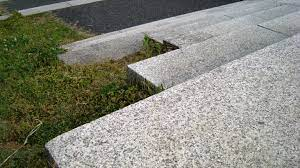Topic 3 – Placing and Finishing Concrete Stairs
The concrete used for stairs should be of a lower slump and contain smaller aggregate to ensure an easier and smoother finish. Placing concrete in stair formwork begins at the bottom tread and moves upwards. Any embeds such as weld plates or anchors can be installed during placement. After the concrete is vibrated, float each tread in the same order as it was placed to maintain a uniform finished riser height. Finishing begins at the top of the form and move down each tread until you get to the bottom step. The riser form will need to be removed to finish the riser. Finishing the risers can be done soon after finishing the treads while the concrete is stiff but still workable or after several days by patching with a grout rubdown or parging.
A slip resistant finish to the stairs can be made by:
- Brooming
- Float finish
- Swirl-trowelling
- Exposed aggregate
- Grooves cut into the surface
- Abrasive grits trowelled in during finishing (silicon carbide, aluminum oxide, carborundum)
- Abrasive strips embedded into the wet concrete.

Source: https://pxhere.com/en/photo/1012527
Review Instruction Sheet (IS) on Brightspace:
STRS 301 Concrete Stairs (2019), (p. 21 – 23)
- IS 3.1 Place and Finish Concrete for Stairs
Review Questions
- When pouring a set of concrete stairs, a slump of _____ to _____ is recommended.
- For all exterior stairs, _____ cement should be used
- List seven ways of providing a slip-resistant finish on concrete stairs when finishing the concrete
- If a metal handrail is to be installed on the edge of the landing and stairs, the uprights can be embedded into the concrete while it is being poured or:
- True or False:
- Heaving soil under precast steps can damage the steps and/or foundation wall to which they are bolted.
- Large precast stair units may require concrete piles under their outer ends for extra support.
- Two or three precast units should not be used together for a wide entryway.
- Cast-in-place stairs usually have a better finish on them than precast stair units.
- Precast units may sit directly on a sidewalk, driveway, or patio slab.
- Precast stairs can sometimes be welded into position
Answers:
- 50-75 mm
- Sulphate-resistant (type 50)
- Brooming, floating, swirl-trowelling, exposed aggregate, cutting grooves into the surface, trowelling in abrasive grit, embedded abrasive strips
- Cast weld plates into the concrete, use concrete anchors or shields, form a void in which to embed the upright later
-
- True
- True
- False
- False
- True
- True
